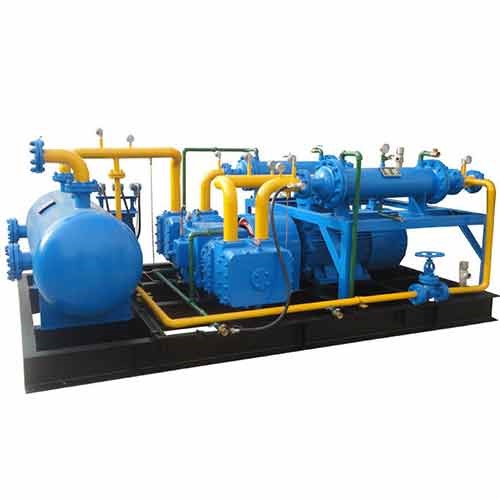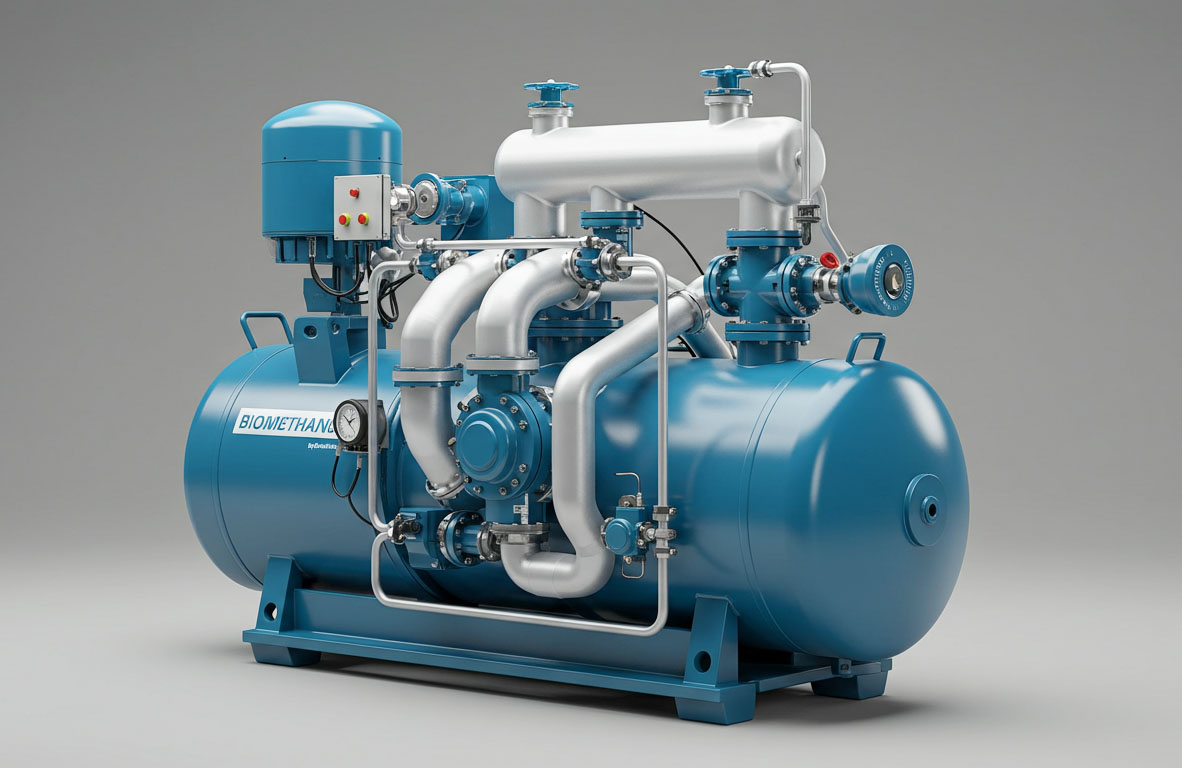Mixed Gas Compressors: An Overview of Its Function and Applications
Mixed gas compressors are integral components of many industrial processes that involve handling gasses. These compressors are specifically designed to accommodate gas mixtures that vary in terms of composition and properties; as a result, they’re highly valued tools in areas like oil and gas exploration, chemical processing, and other industrial settings.

Mixed gas compressors come in various designs and configurations, each one offering unique design and operational characteristics. Common examples are centrifugal, reciprocating, and screw compressors – each type having their own set of benefits and drawbacks; making the selection of one the result of knowing the precise application needs.
Mixed gas compression presents several key considerations that must be taken into account to achieve optimal performance and reliability, including the selection of materials, lubrication systems, cooling systems and operational challenges such as contamination, pressure pulsations or surge. Furthermore, to ensure safe and efficient operations.
Key Takeaways
- Mixed gas compressors are widely used in industrial processes that involve handling gas mixtures with varying compositions and properties.
- There are different types of mixed gas compressors, and the choice of compressor depends on the specific application requirements.
- Design considerations such as material selection, lubrication, and cooling systems, as well as operational challenges such as gas contamination and surge, must be addressed to ensure safe and efficient operation.
Fundamentals of Mixed Gas Compression
Mixed gas compression is the practice of compressing gasses that contain two or more components. It is employed across industries including oil and gas, chemical manufacturing and food and beverage manufacturing to increase pressure to meet process specifications. The goal is for increasing pressure until process requirements have been fulfilled.
Mixed gas compressors are designed to accommodate an assortment of gasses and mixtures. They can compress gasses with different molecular weights, specific heats and compressibility factors – their performance depends upon the composition of the mixture being compressed as well as operating conditions and design features of the compressor itself.
Mixed gas compressors fall into two broad categories: centrifugal and axial compressors. Centrifugal compressors are generally preferred for lower pressure applications while axial compressors may be better suited to higher-pressure situations. Their design depends on properties associated with your gas mixture’s density, viscosity and molecular weight.
Mix gas compression can be achieved using either a single-stage or multi-stage compressor, with the latter typically used in high pressure applications where single stage compressors cannot achieve required pressure ratios. A single stage compressor compresses gas mixtures in one stage while multi stage compressors compress multiple stages. A multi stage compressor can compress gas mixtures more rapidly.
Compression generates heat, which can increase the temperature of gas mixtures during compression. To avoid overheating, compressors come equipped with cooling systems that remove this heat generated during compression using either water, air, or refrigerants as coolant to keep their temperatures within safe limits.
Mixed gas compression refers to compressing gases with multiple components into one gas mixture. It’s used across various industries and can be achieved using centrifugal or axial compressors, while their design depends on the mixture itself; additional heat generated during compression must be managed through a cooling system.
Types of Mixed Gas Compressors
Mixed gas compressors are used across multiple industries to compress gases containing multiple components. There are three primary types of these mixed gas compressors: centrifugal compressors, reciprocating compressors and screw compressors; each type offers its own benefits and drawbacks.
Centrifugal Compressors
Centrifugal compressors are widely utilized in gas compression applications due to their efficiency and reliability. Centrifugal compressors work by accelerating gas at high velocity before converting its kinetic energy into pressure. Centrifugal compressors excel at compressing large volumes at lower pressure ratios.
Reciprocating Compressors
Reciprocating compressors are positive displacement compressors that use pistons to compress gas. They are best used in applications requiring high pressure ratios with lower flow rates, making them highly efficient yet cost-efficient – however they do require more maintenance than other types of compressors.
Screw Compressors
Screw compressors are positive displacement compressors that use two intermeshing screws to compress gas. They’re ideal for applications requiring high flow rates at moderate pressure ratios; their reliability outstrips other types of compressors though.
Overall, centrifugal compressors are suitable for compressing large volumes of gas at lower pressure ratios; reciprocating compressors excel in applications requiring high pressure ratios but low flow rates; while screw compressors excel when applied to applications requiring high flow rates with moderate pressure ratios.
Design Considerations for Mixed Gas Compressors
Mixed gas compressors are widely used across various industrial applications for compressing gases with differing properties. Designing such a device requires careful consideration of several factors in order to ensure optimal performance and longevity of such compressors, so in this section we will look at some key design considerations for mixed gas compressors.
Material Selection
A key aspect of designing mixed gas compressors is material selection, as this must withstand the corrosive properties of compressed gases while being resilient enough for operation under temperatures and pressure conditions that might arise during their usage. Common materials found in mixed gas compressors include stainless steel, carbon steel, and aluminum.
Pressure Ratios
Another key design consideration for mixed gas compressors is pressure ratios. A pressure ratio refers to the ratio between discharge pressure and suction pressure, which impacts efficiency and performance of the compressor. A higher ratio can increase efficiency but can increase risks due to temperature and pressure extremes, thus must be carefully chosen based on application needs.
Temperature Control
Temperature control is another important design consideration for mixed gas compressors. A compressor must be capable of accommodating for changes in temperature that arise during compression without incurring damage to its components, leading to early failure. Therefore, an effective cooling mechanism such as cooling fluids or air cooling systems must be provided to help keep temperatures within safe levels for optimal operating temperatures.
Designing a mixed gas compressor requires careful consideration of many factors, including material selection, pressure ratios and temperature regulation. Engineers can take into account these considerations when designing compressors that deliver optimal performance and longevity.
Mixed Gas Compressor Operational Challenges

Compressing gases of different composition is used across numerous industries, but operating these compressors can present unique operational challenges that need to be considered carefully. In this section we’ll explore some of these challenges associated with mixed gas compressors.
Gas Composition Variability
One of the main challenges of operating mixed gas compressors is dealing with the variability of gas composition. The composition of the gas being compressed can vary significantly depending on the source, which can create operational issues. For example, if the gas composition changes, the compressor may not be able to handle the new composition, leading to reduced efficiency or even failure. To overcome this challenge, it is important to monitor the gas composition regularly and adjust the compressor accordingly.
Corrosion and Wear
Another challenge associated with mixed gas compressor is corrosion and wear. The presence of corrosive gases can cause damage to the compressor components, leading to reduced efficiency and increased maintenance requirements. In addition, the high pressure and temperature of the gas being compressed can cause wear on the compressor components. To mitigate this challenge, it is important to select materials that are resistant to corrosion and wear and to perform regular maintenance on the compressor.
Maintenance Requirements
Mixed gas compressor require regular maintenance to ensure they operate efficiently and safely. The maintenance requirements can vary depending on the type of compressor and the gas being compressed. Some common maintenance tasks include cleaning, lubrication, and inspection of compressor components. It is important to follow the manufacturer’s maintenance recommendations to ensure the compressor operates reliably and efficiently.
In summary, mixed gas compressors are essential in many industries, but they come with their own set of operational challenges. Gas composition variability, corrosion and wear, and maintenance requirements are just a few of the challenges that need to be taken into consideration when operating these compressors. By monitoring gas composition, selecting appropriate materials, and performing regular maintenance, these challenges can be mitigated, and the compressor can operate efficiently and safely.
Applications of Mixed Gas Compressors

Mixed gas compressors are used in various industries for a wide range of applications. Some of the most common applications of mixed gas compressors are discussed below.
Oil and Gas Industry
In the oil and gas industry, mixed gas compressors are used to compress natural gas, which is then transported through pipelines. These compressors are also used to inject gas into oil wells to enhance oil recovery. Mixed gas compressors are preferred in the oil and gas industry due to their ability to handle a wide range of gases, including sour gases, which are corrosive and can cause damage to the compressor.
Chemical Processing
Mixed gas compressors are used in chemical processing plants to compress a variety of gases, including hydrogen, nitrogen, and oxygen. These compressors are used to transport gases from one part of the plant to another, or to store gases in tanks. In the chemical processing industry, mixed gas compressors are preferred due to their ability to handle a wide range of gases and their high efficiency.
Power Generation
Mixed gas compressors are used in power generation plants to compress air for gas turbines. These compressors are used to increase the pressure of the air entering the gas turbine, which increases the efficiency of the turbine. Mixed gas compressors are also used to compress the exhaust gases from the gas turbine, which are then used to generate steam for power generation.
In conclusion, mixed gas compressor are versatile machines that find applications in a wide range of industries. They are preferred due to their ability to handle a wide range of gases and their high efficiency. The oil and gas industry, chemical processing, and power generation are some of the major industries where mixed gas compressor find widespread use.


